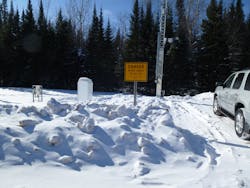The Great Winter of 2013-14 will be remembered by tens of millions as one of the coldest and snowiest in memory. For months on end extreme weather conditions pummeled the Eastern Seaboard, Midwest and even the Deep South with some of the largest snowfall volumes and lowest temperatures recorded.
However, having to shovel a car out of a snow drift, wait endlessly for a bus or train or be housebound for days at a time are minor annoyances compared with the challenges faced this winter season by the departments of transportation (DOTs) of dozens of states. During the heat of the summer, drivers think that winter is far away. However the DOT is now thinking ahead to the next winter and how it can better protect driver safety.
In addition to being responsible for the mobility and safety of citizens through the design, construction and maintenance of roadways, bridges and mass transit systems, DOTs must respond promptly to all manner of weather conditions, ensuring thoroughfares are usable, passable and safe. Without the constant vigilance of DOT administrators and the fleets of snowplows, trucks and specialized equipment they dispatch when blizzards, flooding or downed trees and power lines occur, commuters, pedestrians, law enforcement and emergency vehicles would be immobilized.
Thanks to a new generation of road-condition sensors, weather stations and other remote-monitoring technologies, “smart” roadways are helping transportation officials get the job done more efficiently and cost-effectively than ever before.
For more than eight long months last winter the Michigan DOT (MDOT) dealt with periods of prolonged deep freeze, a run of cold weather unusual even for this northern state used to stormy and icy conditions. Unlike past winters of exceptionally harsh weather, state officials benefitted from a data-gathering network of 33 environmental sensor stations (ESSs), feeding real-time information into three regional monitoring centers. Although installed nearly a decade ago, the statewide ESS was put to its most rigorous test yet by the record snowfall and prolonged deep-freeze conditions that began in October 2013, according to Mike Lusk, an engineer at MDOT’s Newberry Transportation Service Center.
“The road sensors and other capabilities of an ESS provide a whole package of monitoring capabilities to the department,” Lusk said. “Everyone wants to see as complete a picture as possible of what the road is like at this very instant. By feeding real-time into the MI Drive website, the general public can plan their route and be reassured about driving a certain stretch of road.”
Having the Drive
Launched as a service to Michigan drivers, MI Drive is an online traffic and construction information resource developed by MDOT to enable drivers to quickly view maps showing current road and traffic conditions. Visitors to www.michigan.gov/drive also can view live video images being streamed online, up-to-the-minute weather information and even report potholes.
Being bounded by three of the five Great Lakes, the state of Michigan is especially vulnerable to freezing temperatures and high precipitation blowing in from Lake Superior, Lake Michigan and Lake Huron, said Traffic and Safety Engineer Dawn Gustafson.
“Wind direction and gust information enables us to determine where and when roads, especially along the lakes, may drift in and need to be closed,” Gustafson said. “Continually monitoring pavement-temperature, air-temperature and dew-point readings enables Superior Region personnel to make better decisions on when and how to treat roadways, which is very helpful with dangerous black ice or when bridge decks freeze.”
The main components of 20 of these ESS systems consist of road-condition and atmospheric sensors with advanced analytical software and communication. An ESS typically used for road safety consists of atmospheric sensors specifically designed to measure precipitation intensity, quantity and accumulation with very fast response time. A doppler radar is often preferred for measurement of precipitation. The advanced, maintenance-free sensor measures by scanning the falling rain drops, measuring their fall rate and diameter. By these data points the sensor extrapolates the critical data points for the ESS. Wind, temperature, humidity and barometric pressure also are included in the station and critical measurement points for forecasting conditions of the roadways.
Lufft USA is one vendor that offers this road technology. The company offers two types of road sensors, embedded and “noninvasive.” The company’s embedded roadway devices are installed flush to the asphalt or concrete surface and detect road condition. The noninvasive road sensors are pole-mounted and measure pavement condition with advanced optics. Road condition diagnostics consist of transmitting current road status: dry, damp, wet, icy, snow/ice mix or snow.
There are two types of embedded roadway sensors. A passive sensor measures the pavement temperature, water-film height and salt concentration by conductivity measurement. It also gives information about the friction of the road surface, no matter the type of surface. By using friction values customers can easily classify the road status the same as a standard stoplight: red (bad grip), yellow (critical grip) and green (good grip). An active embedded sensor measures the salt concentration on the road independent of type of liquid by means of heating and cooling.
Another sensor used by MDOT for surface condition measurement is a noninvasive road sensor. This sensor uses ultraviolet light coupled with advanced optics to measure varied reflectivity of different road surface conditions. The same parameters are found as the embedded road-surface sensors, but there is no need for any cuts in the road for installation. This is at times much preferred. The Michigan ESS hardware vendor, Lufft, holds a patent for freeze-point measurement with the optical noninvasive road sensor.
“All of these measurements are crucial to tracking how weather is affecting the highways, bridges and city streets across the state,” said Gustafson. “Having real-time pavement temperature data alerts us to warming pavement temperatures, which would be conducive to salt application,” Gustafson stated. “Since we do not apply salt when pavement temps are low, every window of opportunity we can get to apply some material to help keep the roads clear is helpful.”
“Precipitation timing forecasts enable us to better plan resources, from scheduling snowplow drivers to use of salt and other resources,” said Gustafson. “For example, precipitation-accumulation estimates help us to determine if we should remove existing snowbanks in the cities to make room for the new snow prior to an incoming storm.”
MDOT administrators state that even a cursory review of an ESS site is helpful, especially for getting a handle on unpredictable lake-effect weather.
“The cameras are great, as sometimes it is impossible to predict lake-effect snow [LES] and how much is coming down, and also the fact that most times LES doesn’t show on radar in certain areas,” commented Lusk. “But the road temp, air temp, dew point, existing chemical sensors, etc., really paint a clear picture of what the road is going to do in the future, given a certain forecast, so we can keep that road at our customer’s expectations, which are rather high these days. We certainly don’t rely solely upon the ESS/MDSS system; there’s no replacement for hands-on experience in winter-maintenance activities, but it is a great tool to have in the toolbox.”
Doug Noble, transportation maintenance supervisor at the Newberry Transportation Service Center: “An ESS forecast predicted a snow event on Dec. 16, 2013. Using a Maintenance Decision Support System [MDSS] kept us ahead of the game and made us proactive instead of reactive. Who knows, that effort might have saved a life.”
“Data from the MDSS said it would be snowing by 9 p.m. and I only had three transportation maintenance workers working that night. I told the lead worker this and said that I would watch the weather forecast on the news and call him, and we would decide rather to call in three more TMWs ahead of the storm. Based on these two forecasts I talked with the lead worker and had him call in three people to be at the garage at 8 p.m. so they could get their trucks checked over and loaded with salt and be ready to roll before nine. It started snowing at about 8:50 p.m., so by making this decision we were ahead of the game instead of behind. We have only had this system for a week but I feel that the MDSS site may be one of the best tools we have in our toolbox.” R&B



